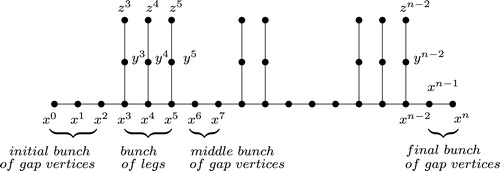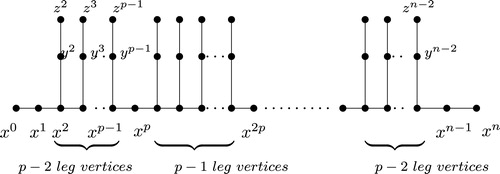 ?Mathematical formulae have been encoded as MathML and are displayed in this HTML version using MathJax in order to improve their display. Uncheck the box to turn MathJax off. This feature requires Javascript. Click on a formula to zoom.
?Mathematical formulae have been encoded as MathML and are displayed in this HTML version using MathJax in order to improve their display. Uncheck the box to turn MathJax off. This feature requires Javascript. Click on a formula to zoom.Abstract
A -labeling of a graph is a labeling of vertices of the graph by
-tuples of non-negative integers in such a way that two vertices of
are adjacent if and only if their label
-tuples differ in each coordinate. The dimension of a graph
is the least
such that
has a
-labeling.
In this paper we obtain the dimension of a lobster or close bounds for it in various cases.
1 Introduction
For a given graph (symmetric without loops), label the vertices by vectors of length
with nonnegative integer coordinates in such a way that two vertices are joined by an edge if and only if the corresponding coordinates in their labeling are all different. Such a labeling is called a product representation of
. The least such
is called the dimension of
. It is also the minimal number of complete graphs whose direct product (i.e. tensor product) contains
as an induced subgraph. This dimension is denoted as
or product dimension of
or
in the literature. Since
is used in other contexts too, we shall use the notation
in this paper.
A caterpillar is a graph which reduces to a path (called spine) after removing its pendent vertices. A lobster is a graph which reduces to a caterpillar after removing its pendent vertices. In this paper, we shall obtain dimension, or close upper and lower bounds for the dimension, for some classes of lobster.
Remark 1.1
A Criterion for Adjacent Vertices in Terms of an Inner Product Obtained from Labeling [Citation1] Put .
Then . For a vector
define vectors
by putting
(1.1)
(1.1)
and
have
coordinates corresponding to subsets
. Clearly
(1.2)
(1.2) where the notation
designates the inner product of
and
.
In any product representation of a graph , two vertices are adjacent if and only if their labels
and
satisfy
. This result will be used for getting a lower bound for the dimension of a lobster in Section 2.
For earlier results on the dimension of a path, cycle and caterpillar see [Citation1–4].
2 A lower bound for the dimension of a lobster
A lobster is a tree in which the removal of leaves (pendent vertices), leaves a caterpillar. Alternatively, consider stars with centers at
,
. Let
be a graph obtained from
in which some of the legs in
may be further subdivided by a vertex. Next join
to
,
. The resulting graph is called a Lobster. (See .)
In this section and in Sections 3 and 4 we find bounds for dimension of a lobster and in certain cases, exact value of the dimension. Throughout this paper we denote by a lobster with a diametral path
. Obviously
contains the spine of
.
Note 2.1
Let be a lobster with
where
. Let
. For
,
is called a leg vertex or a base-leg vertex. For
, let
be the vertex of
of degree
joined to
, and
be the pendent vertex of
joined to
. These three vertices form a leg (or path) of length
. Call
a mid-leg vertex and
a pendent-leg vertex of the lobster
. Thus the vertex set of
is
and the edge set of
is
and
for
are the pendent vertices of
. If
,
is called a gap vertex or a non-leg vertex. Thus a leg vertex is of degree
and a gap vertex
,
, is of degree
.
Let be consecutive leg vertices of
and suppose that
and
are gap vertices, i.e.
for
but
. We call the induced subgraph on
,
and
,
, a bunch of legs. The induced subgraph (path) on all gap vertices between consecutive bunches of legs is called a bunch of middle gap vertices. Note that, initial and final bunches of gap vertices in
have at least two vertices each. Let
. From now on, our lobsters
will have all the legs of length
.
Theorem 2.1
Let ,
, be a lobster of length
where
and let
,
, be at most
. If all legs of the lobster are of length two and the initial and final bunches of non-leg vertices have at least two vertices, then
satisfies the inequality,
Proof
Let . Consider
encoded in
by a product representation. For
,
,
where
and
are
-tuples as defined in Eq. (1.1). For a vertex
, consider the
-tuple
obtained by the embedding of
in
and obtain
-tuples from this using (1.1). We denote these
-tuples for convenience by
and
. Similarly, we get
and
from the vertex
and
and
from the vertex
. Now
for
, and for
,
. As encodings of adjacent vertices agree in no coordinate, we get
, and similarly for
,
and
. Also for
,
if
; for
,
and for
and
,
,
if
, and also if
,
for
, as encodings of non-adjacent vertices agree in at least one coordinate. We shall now show that the vectors in
corresponding to the vertices
,
and
,
,
, are
-linearly independent, so that
. Let
(2.1)
(2.1)
We shall take the dot product of Eq. (2.1) with suitable ,
and
to show that
, for all
appearing in (2.1). Take the dot product with
,
, to get
for
. Now we consider the vertices
(
) of the diametral path
one by one from
. Taking dot product with
, we get
for
. Now take the dot product with
,
, to get
for
. (See .)
Thus, we get vectors in
which are
-linearly independent. Therefore
. Hence,
.
Fig. 2 The lobster in Theorem 2.1.

3 An upper bound for the dimension of a lobster
Theorem 3.1
Let ,
, be a lobster of length
and let
be the vertices of the spine of
with
for
,
for
,
and
for
,
. Let
be a path of length
, which is the leg at
for
. Then
.
Proof
To get the desired upper bound for , we first show that the lobster
can be embedded in
. We consider the diametral path of
given by
-
-
-
. In analogy with a theorem of Lovász et al. ([Citation1], Theorem 5.6), we define vectors
,
and
corresponding to the vertices
with
inductively as follows:
For , define
,
, by
Again for , define
and
for
,
,
.
Now for , define
,
, by
Again for , define
and
,
, by
For , we now define
for
by
Again for , we define
and
,
, by

We see that the labeling works initially for . When we go from
th stage of induction to
th stage, it is to be observed that we have essentially joined two
to get an
; and in this process for
, we initially have non-leg vertices which become leg-vertices in the
th step. Hence, these three vertices are to be treated somewhat differently. From the given formulas, we see that the adjacent vertices agree in no coordinates and the nonadjacent vertices either agree in the first
coordinates coming from induction or agree in the (new) last coordinate. (See .)
This shows that the lobster can be embedded in
and
. Now if
, then
is an induced subgraph of
and so
. Hence, for any
,
.
Fig. 3 The Lobster in Theorem 3.1.

4 Dimension of a lobster
In this section we shall get upper and lower bounds for the dimension of a general lobster considered in Theorem 2.1. Then we consider two types of lobsters for which we get dimension for most . In the lobsters considered in this section, for vertex
and having degree
, there is a leg
-
-
associated with it, with
as a mid-vertex and
as a pendent vertex.
Theorem 4.1
Let be a lobster of diameter
as considered in Theorem 2.1 . Then
Proof
In the notation of Theorem 2.1, there are
s and at least
and
, so
. Thus
. Hence
.
Now is an induced subgraph of the lobster considered in Theorem 3.1. Hence
.
Theorem 4.2
Let ,
, be the lobster considered in Section 3 . Then
In particular, if , then
.
Proof
In the notation of Theorem 2.1, there are
s,
s and
s, so
. Hence
.
On the other hand, in Theorem 3.1 we proved that dimension satisfies
. Hence,
.
Now let , so
. Hence,
.
Theorem 4.3
Let ,
, be the lobster considered in Theorem 4.2 . Let
. The dimension of
is given by
For ,
.
Proof
If , we show that,
. Let
, so
. Hence,
. Hence for some
,
Now, by Theorem 4.2, . So
Thus, , so that,
.
Example 4.4
Take . For
,
.
Let . Now we shall consider a lobster with sets of bunches with
leg vertices followed by a gap vertex, except that for
, initial and final bunches of leg vertices contain
leg vertices.
Theorem 4.5
Let . Let
,
, be a lobster of length
with
be the vertices of the spine of
and let
or
according as
or
for
. Let
,
. Let
if
and
if
. The dimension of
satisfies the inequality,
Let . In particular, for
,
For ,
.
For ,
,
.
For ,
. For
,
.
For ,
,
. (See .)
Proof
Here where
if
and
if
. Therefore by Theorem 2.1,
, where
if
and
if
.
Now as is an induced subgraph of the lobster of Theorem 3.1, say
, we get
. By Theorem 3.1,
. Thus,
(∗)
(∗)
Let . Take
so that
. As
, we have
. Thus
. Now the lower and upper bounds in
will be equal if
, i.e.
, where
(
), i.e.
, i.e.
, i.e.
, i.e.
.
Further,
Hence in any case we get equality for lower and upper bounds in
if
, and then
for
,
. Here
, so
. Hence for
, the condition
is not satisfied. Hence we take
.
Let . Note that if
is replaced by
, in the new lobster
, we have one additional vertex
. Also, at the vertex
, there will be two new vertices
,
if and only if
. Thus we get
or
new vertices if
is replaced by
. Thus
increases with
.
Let and
. Now if
, then
. So
. Hence for
, we have
,
and so
. For
,
,
, so
and for
,
, so
.
Now let , so
. Hence
, so
. Thus, for
,
.
For ,
, so
. In fact
, as we can label
by triplets as follows:
For ,
. By a similar labeling, we have checked that
for these
, for
.
Now let . Let
,
. Here,
. Thus,
for
even, and
for
odd. Hence, by Theorem 2.1, for
even or odd,
.
Acknowledgment
The research of the second author was supported by research and development grant of Department.
References
- LovászL.NešetřilJ.PultrA., On a product dimension of graphs J. Combin. Theory Ser. B 291980 47–67
- EvansA.B.FrickeG.H.ManeriC.C.McKeeT.A.PerkelM., Representation of graphs modulo n J. Graph Theory 181994 801–815
- EvansA.B.IssakG.NarayanD.A., Representation of graphs modulo n Discrete Math. 2232000 109–123
- KatreS.A.YahyaeiL., Dimension of a caterpillar JCMCC 982016 3–15


